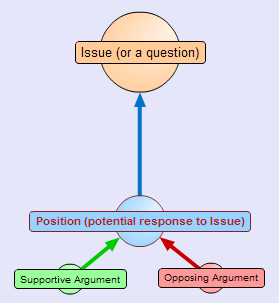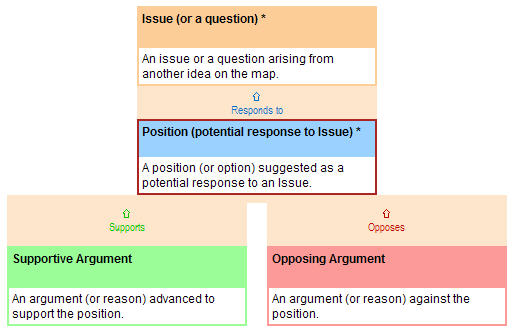Standard five of the National Educational Technology Standards for Teachers states that teachers should strive to continue their education and learning, becoming life-long learners and thus, better educators. They should also demonstrate and teach this knowledge of digital tools and resources for their peers, allowing their school and professional community to be become adept to the technologies as well. This can be achieved through the participation of the teacher in learning communities, both locally and world-wide, through which they can explore innovate ways of using technology to improve student achievement and learning. It can also be achieved through continuous reflection and evaluation of current trends and research in education, allowing the teacher to stay up-to-date with new technologies, tools, and resources that can further student learning. In fulfillment of this standard, I researched and explored a new technology called DebateGraph to be used in my Social Studies classroom. This new technology will assist my students in organizing their thoughts as well as collaborating with their peers both locally and globally on debated topics. In addition, the teacher must demonstrate their leadership by helping to develop and strengthen the technology skills of students and peers, contribute to community building and decision-making, and develop and share a vision of technology integration into their school and classroom. The teacher must also strive to better the teaching profession, their school, and their community through contributions that positively impact and reinforce their effectiveness, strength, and stability.
Standard five states that, “teachers continuously improve their professional practice, model lifelong learning, and exhibit leadership in their school and professional community by promoting and demonstrating the effective use of digital tools and resources.” This means that teachers must be constantly learning and adapting their practices and lessons to reflect any new information or technologies that may come along that can benefit their students’ learning and achievement. It also means that teachers should model and share what they learn and discover with their peers in order to better the school and community. In order to meet this standard, I have created a large network (a personal learning network) comprised of peers, publications, and authorities in education which I can learn from every day. I also participate in discussions with my peers in which I am both a student and a teacher.
The first sub-standard of standard five states that teachers should, “participate in local and global learning communities to explore creative applications of technology to improve student learning.” As previously mentioned, I participate in discussions with my peers, both locally (classmates) and globally (throughout the world via the internet) during which methods of increasing student achievement as well as new technologies in education are discussed. Recently, I participated in a Twitter Chat discussion covering the topic of blogs and how they can be integrated and used in the classroom. From this discussion, I designed a blog project that would replace traditional paper journals in my classrooms, both in day-to-day activities and as part of several projects. In addition, I use a the Google Reader program to stay connected with my peers as well as several educational resources and authorities as part of my professional development.
Sub-standard two states that teachers should, “exhibit leadership by demonstrating a vision of technology infusion, participating in shared decision making and community building, and developing the leadership and technology skills of others.” Technology can be an invaluable resource, however, before utilizing and integrating technology in to the classroom and lessons, teachers must have a solid vision and goal. Integrating technology simply for the sake of integrating technology is not beneficial to the students or the teacher. For this reason, it is important that teachers collaborate with their peers and create a strong plan for technology in the classrooms and in the school. In addition, once a plan is in place and has been deemed successful with regards to student achievement, the teacher or group of teachers should model and assist the rest of the school community in becoming as effective.
According to sub-standard three, teachers are expected to, “evaluate and reflect on current research and professional practice on a regular basis to make effective use of existing and emerging digital tools and resources in support of student learning.” As previously discussed, it is imperative that teachers stay current with research and information in education. One should make it a priority to regularly research new trends and technologies in education and edit and adjust lessons and classroom practices accordingly. If teachers do not take the time to learn new things and explore and integrate new technologies, their students will suffer as a result. We always want our students to have the best resources and technologies available to them to prepare them for the future, and it is the responsibility of the teachers to discover and utilize any new technologies that may be available to them. As previously discussed, I use several resources such as my Google Reader, Twitter, and various websites to ensure I am learning about many new technologies and teaching methods from my peers and other entities.
The final sub-standard states that teachers should, “contribute to the effectiveness, vitality, and self-renewal of the teaching profession and of their school and community.” The teaching profession, schools, and community are continually changing and evolving and it is the responsibility of its members to make positive contributions to ensure that it is changing in a positive manner that is beneficial for both the teachers and the students. In order to positively contribute to these changes, teachers must be responsible to keeping themselves and their practices current and effective. Teachers should participate in professional development and share their knowledge with their peers and the community in order to advance both. Again, I accomplish this through my use of Google Reader, Twitter, and other websites.
In order to be an effective teacher, one must be constantly learning and growing. We must take the initiative to stay up-to-date on research concerning teaching practices and education technologies. We must adjust our teaching practices to reflect this new research and knowledge, making sure to stay current with new technologies and methodology. We must also become leaders in our departments and schools, sharing and teaching our peers the new information and practices we may discover. In fulfillment of this standard, I have created my Personal Leaning Network (PLN) through which I have compiled many resources to keep myself up-to-date on new trends and technologies for use in my classroom to help improve student learning and achievement. In addition, through my PLN, I have made several new contacts and connections which will also help me to stay on top of new trends and advancements. This will benefit my students and help to increase their learning and achievement. Because I am up-to-date on new and current educational technologies, I will be able to select those that will benefit my students in the greatest ways and integrate them into my lessons and classroom very quickly. In addition, though my PLN and connections in the learning community, I am able to learn about new practices from other educators who have tried and tweaked them, allowing me to implement new practices in my classroom effectively. Essentially, I now have a large support network of other teachers helping me to better myself as a teacher, my lessons, and my classroom.
Standard five focuses on teachers staying current with professional and technological trends and being able to effectively integrate these new technologies into their classrooms and lessons, as well as demonstrate their knowledge for their peers and community. I feel I have effectively demonstrated my ability to do so through my artifacts and explanations. While I do feel I am able to effectively integrate new technologies into my classroom, I feel there is always a need to learn and stay up to date with new and emerging trends and technologies. I plan to complete my Master’s in Educational Technology program, which I feel will provide me with valuable knowledge, insight, and tools needed to stay current and up to date. I also plan to continue to attend workshops and trainings focusing on technology in the classroom as long as I am teaching, as well as continue to support and share my knowledge with my peers. In a field such as technology that is constantly changing and growing, teachers can never be satisfied with their current level of knowledge – there is always something new to learn and I feel all teachers, myself included, should never stop learning and updating their lessons and classrooms and it is vital that they impart their knowledge on those around them as well.



